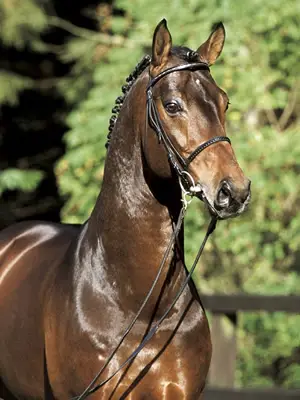General Description
Quality performance prospects are the result of the Hanoverian selection process. Each year the American Hanoverian Society organizes a national inspection tour to register foals, inspect and performance test mares and license stallions. In order for a foal to be registered, both the sire and dam must be AHS approved. German and American inspectors evaluate mares for type, conformation and gaits. The Mare Performance Test scores a mare's rideability, gaits and jumping talent. Mares are placed in various sections of the Studbook based on both their overall scores and their dam's Studbook placement. The very best mares can earn the title of Elite Mare upon successfully completing the Mare Performance Test.
All stallion candidates must be presented for physical inspection. If scores on conformation, movement and jumping ability are sufficient, a temporary breeding license is granted. Within two years, stallions must complete and pass the 100-Day Stallion Performance Test that evaluates gaits, trainability and athletic ability in dressage, show jumping and cross-country. Eligibility for breeding is verified annually.
Certain non-Hanoverian mares and stallions are eligible for inspection and entry into the studbook if they meet strict breed and pedigree requirements and attain sufficient scores upon presentation. A horse with only one AHS approved parent (either Main Studbook dam or an Elite Stallion sire) is eligible for a Certificate of Pedigree, which enables participation in the AHS Awards Program.
Masculinity/Femininity and Typiness: Stallions must have a distinctly masculine bearing and mares a distinctly feminine expression. A horse's type must correspond to the Society's breeding goal.
Conformation: The main part of the body from the chest to the buttocks should fit into a rectangular (not square) frame with all parts harmoniously integrated. Also desired is a noble head with expressive eyes sitting on a well proportioned and well put on neck.; withers that are pronounced and extending far back; sloping shoulders with the angle between the scapula and humerus large and open; a long, broad forearm on a correspondingly short cannon bone; and straight legs. Also preferred is a b, but not tight back that is well padded in the area of the kidney; a long, well sprung hind rib; and a broad slightly sloping croup. Careful attention is paid to the hindquarters -- their angulation, proportion and joint formation. The hocks must be broad, clear and well defined; the pasterns of all four legs must be of proper slope and length; and the hooves should be well shaped, b and sound.
Gaits: Movement as seen from the front and the rear must be straight with no paddling, winging or crossing over.
Impulsion and Elasticity: Impulsion must clearly emanate from the hindquarters, traveling through a relaxed back swinging in rhythm with the gait. Movements should be big, yet light and springy.
Walk: The walk must be ground covering, relaxed and regular. Strides must be even and footfalls correct in their sequence -- not lateral or pacing. Freedom of shoulders and haunches and a supple back must be evident.
Overall Impression and Development: As to size, sound judgement should prevail. Horses should be neither excessively large nor too small. In all cases height should be in proportion to the overall build. Harmony is more important than size. A horse's development must be commensurate with its age.






